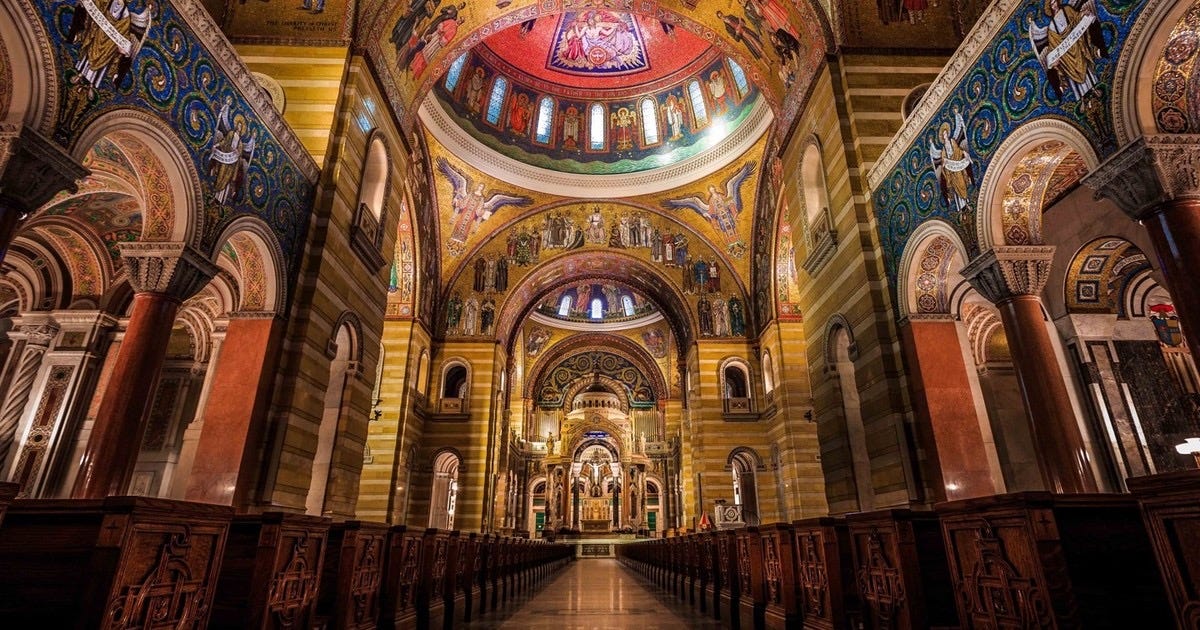Thirsting for the Bread of Life
A Convert’s Journey to the Eucharist
Most mornings since my recent conversion experience, I find myself in the still pews of a sacred cathedral, my heart quietly restless, counting the days to Easter. The arches climb upward, bearing sacred art—golden icons of saints with eyes that seem to see me, each frame a whisper of God’s tale.
Above, the ceiling unfolds in massive domes, vast and curved like the sky’s own embrace, covered with millions of mosaic tiles—blue, gold, red—pieced into scenes of salvation. The light dances on them, and I feel the weight of holiness, a closeness to something eternal.
I am newly part of the Order of Christian Initiation of Adults, a wayfarer on a path I never expected, and there’s an ache in me—deep, urgent—to taste the Eucharist. Each dawn, I rise and come to Mass, drawn like a deer to water, my soul parched for Christ.
I silently murmur prayers, my eyes fixed on the altar where the Bread of Life will soon be mine. I shuffle forward, arms crossed, receiving only a blessing from the priest, and yet I hunger for more—for Christ’s very self. Some evenings, I come for Eucharistic adoration, sitting before the Host in its golden frame, gazing at that small wafer that holds a mystery: bread and wine become Him. Transubstantiation—this strange, quiet paradox—stirs me. How does the finite hold the infinite? I sit with it, letting it unravel me, grappling with the seeming impossibility of a daily miracle happening right before my eyes, theologically significant but escaping the verification of my senses.
Once I walked in darkness, an atheist for a decade, tethered to Charles Sanders Peirce and his pragmatism. He scorned transubstantiation as metaphysical nonsense—no public measure, no observable act could prove Jesus’ substance beneath the wafer’s form. If it didn’t “cash out” in the tangible, he said, it was empty. I nodded then, content with that cold logic, thinking it absurd that anyone could believe in this doctrine let alone make it a central pillar of devotion and worship.
But now, Eucharistic miracles break through my old walls—Hosts that bleed, that turn to flesh under a microscope, defying reason yet bearing witness. These signs, measurable yet unexplainable, kindle my faith where Peirce’s pragmatic rule falls short.
I was Southern Baptist once, a boy shaped by hymns and fiery sermons, where the Lord’s Supper was a mere symbol—bread and juice in trays, a memory, an afterthought, nothing deeper.
Now the Real Presence has undone me, largely owing to my voracious appetite for Catholic theology from scholars such as Dr. Scott Hahn. Scripture and liturgy breathe differently—Christ isn’t distant; He’s here, body and blood, in this quiet Host. It shifts everything, like light scattered by those golden mosaics.
As a once-atheist who prided himself on being a hard nosed empiricist, this new reality forces me to quiet my lifelong habit of skepticism and give myself up into the mysteries of faith, to humble myself and turn off my intellectual pride so that I might enter a more contemplative mode of thought.
I now long for communion, for that grace to flood my frail being, to draw me into God. Temptations linger—old addictions, sins I wrestle in silence—and I need the Eucharist’s strength to stand against them, to walk toward holiness. Each day, I kneel, not just for bread, but for the life it carries.
I so desperately want to be a saint—not for glory, but to live so near Christ that heaven seeps into my hours. This Easter, when I receive Him at last, I’ll step into a truth I once passed by—a Baptist boy, an atheist, now a Catholic, still seeking, soon to be filled, beneath these domes where mosaic tiles gleam with God’s vastness.



this was so beautiful to read. we are on the same journey, as I am also preparing to become Catholic this Easter and receive the Eucharist for the first time. like you, I am thirsting after it, and after experiencing Him in this most tangible way. thank you for sharing your beautiful story!
Beautiful reflection, brother! Have you ever read Gerard Manley Hopkins’ English translation of St. Thomas Aquinas’ majestic hymn Adoro Te Devote? That’s my favorite hymn of all.